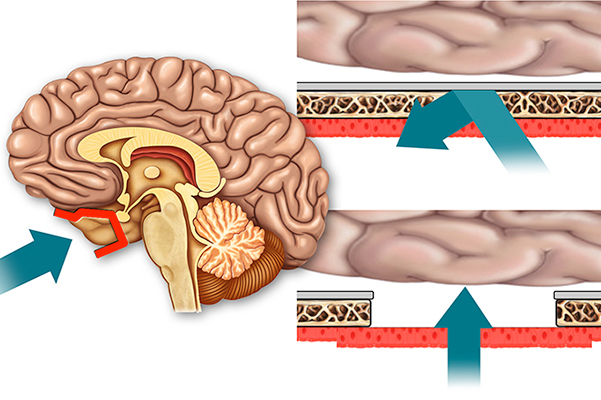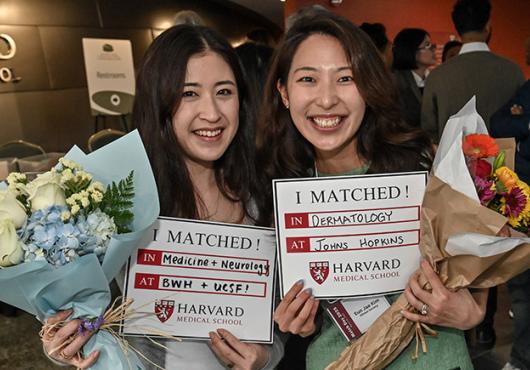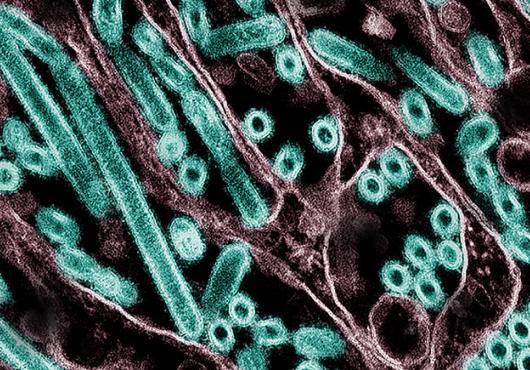
Illustrated concept of an experimental method for delivering drugs to treat a variety of central nervous system diseases. Image: Benjamin Bleier and Garyfallia Pagonis
Researchers at Harvard Medical School, Mass. Eye and Ear and Boston University have prevented the development of Parkinson’s disease in a mouse using new techniques to deliver drugs across the naturally impenetrable blood-brain barrier.
Although the work has so far only been conducted in animal models, the team’s findings, published in Neurosurgery, lend early hope to patients around the world with neurological conditions that are difficult to treat due to a barrier mechanism that prevents approximately 98 percent of drugs from reaching the brain and central nervous system.
“We are developing a platform that may eventually be used to deliver a variety of drugs to the brain,” said senior author Benjamin Bleier, HMS assistant professor of otology and laryngology at MEE.
 “Although we are currently looking at neurodegenerative disease, there is potential for the technology to be expanded to psychiatric diseases, chronic pain, seizure disorders and many other conditions affecting the brain and nervous system down the road,” Bleier said.
“Although we are currently looking at neurodegenerative disease, there is potential for the technology to be expanded to psychiatric diseases, chronic pain, seizure disorders and many other conditions affecting the brain and nervous system down the road,” Bleier said.
The researchers delivered glial-derived neurotrophic factor (GDNF), a known therapeutic protein for treating Parkinson’s disease, to the brains of mice using nasal mucosal grafting. They showed through behavioral and histological data capture that their delivery method was equivalent to direct injection of GDNF—the current gold standard for delivering this drug in Parkinson’s disease despite its traumatic nature and high complication rates—in diffusing drugs to the brain.
The researchers chose to test their delivery method with GDNF because the therapy has been shown to delay and even reverse disease progression of Parkinson’s disease.
Nasal mucosal grafting is a technique regularly used in the ENT field to reconstruct the barrier around the brain after surgery to the skull base. ENT surgeons commonly use endoscopic approaches to remove brain tumors through the nose by making a window through the blood-brain barrier to access the brain. Once they have finished the treatment, they use adjacent nasal lining to rebuild the hole in a permanent and safe way. The safety and efficacy of these methods have been well established through long-term clinical outcomes studies in the field, with the nasal lining protecting the brain from infection just as the blood-brain barrier has done.
Bleier saw an opportunity to apply these techniques to the widespread clinical dilemma of delivering drugs across the barrier to the brain and central nervous system.
By functionally replacing a section of the blood-brain barrier with nasal mucosa, which is more than 1,000 times more permeable than the native barrier, surgeons may create a “screen door” to allow for drug delivery to the brain and central nervous system.
The technique has the potential to benefit a large population of patients with neurodegenerative disorders, where there remains a specific unmet need for blood-brain-penetrating therapeutic delivery strategies.
“We see this expanding beyond Parkinson’s disease, as there are multiple diseases of the brain that do not have good therapeutic options,” Bleier said. “It is a platform that opens doors for new discovery and could enable drug development for an underserved population.”
The study was supported by a grant from the Michael J. Fox Foundation for Parkinson’s Research and represents a collaborative effort between Mass. Eye and Ear and Xue Han of the Biomedical Engineering Department at Boston University. Other authors include Richie Kohman, Kevin Guerra, Angela Nocera, Shrestha Ramanlal, Armine Kocharyan and William Curry.
Adapted from a Mass. Eye and Ear news release.


